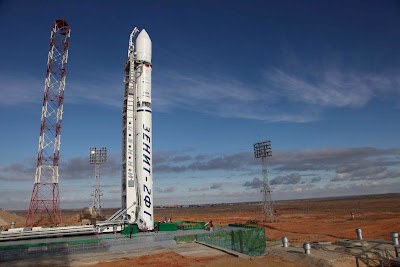The space around Earth is a lot less empty than it used to be. With hundreds of operational satellites, the International Space Station, manned space vehicles, and unmanned cargo ships, it seems things can get pretty crowded up there. However, the vast majority of objects in orbit around Earth is not functioning satellites or housing for astronauts, it's space junk.
A map showing space debris populations in Earth orbit (NASA).
Space junk, or space debris, comes from a variety of sources. Derelict satellites, discarded upper stage rocket engines, and fragments from explosions and collisions circle the world in both low Earth orbit and higher, geosynchronous orbits. A satellite can remain in orbit for years after it stops functioning. Vanguard 1, the first solar powered satellite, was put into a medium Earth orbit in 1958 and ceased communicating with ground controllers in 1964. Yet, this now useless relic will remain in orbit for another
240 years.
The problem with all this space debris is that it is starting to pose a real threat to operational satellites and humans in Earth orbit. The
European Space Agency estimates there are over 600,000 objects in orbit that are larger than 1 cm. And when traveling at over 23,000 kph, even a fleck of paint can cause a catastrophe when it collides with, say, the International Space Station.
A fleck of paint smashed into Challenger's window, causing this crater on shuttle mission STS-7 (NASA).
The situation isn't getting better any time soon, either. Some experts now think that we have reached a tipping point, where there is now so much debris that objects will begin colliding with each other creating more debris at an exponential rate. If that is indeed the case, it might soon be impossible for humans to safely travel into orbit, or even loft a satellite without the danger of it being obliterated in a vast sea of deadly space junk. Indeed, just two years ago a defunct Russian satellite collided with a US communications satellite, destroying both and creating an extra 2,000 pieces of debris.
Mitigating the danger from space debris has already become a priority at
NASA and in the international space community. Ground based radar stations track much of the debris, but pieces under 10 cm can be difficult to detect with radar. Knowing where the junk is can help astronauts be prepared for potential disasters, or help them know where to maneuver spacecraft to avoid a collision. And now, after satellites have completed their operational lives, many are purposefully put into a decaying orbit that can cut down the time they will remain in orbit by decades.
The Goldstone antenna is capable of detecting debris as small as 2mm (NASA).
These steps may not be enough, however. There are several plans in the works to actively "de-junk" space. One
plan, called the ElectroDynamic Debris Eliminator (EDDE), involves sending up cheap, lightweight satellites that use Earth's magnetic field for power and propulsion. These satellites would be equipped with deployable nets to ensnare pieces of space junk, and drag the debris down to a decaying orbit. Another plan involves moving debris into orbits that don't intersect with today's working satellites by using lasers. A stream of photons impacting on a small piece of debris could move it up to 1 mm per second. While that may not seem like a lot, over the course of several days that could add up to kilometers.
Whatever action is decided upon, certainly this clean-up effort will need to be an international one. Dozens of nations operate satellites, and even the derelict satellites are still property of the nations that sent them up there. Let's hope the space community comes to a swift decision, and implements a solution soon. Space is risky enough as it is, removing the threat of space debris will be a big step toward sustaining a safer environment for satellites and astronauts.
Read more about
space junk.
































